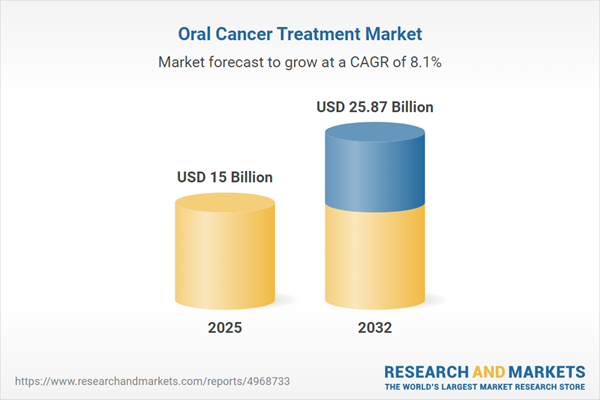Speak directly to the analyst to clarify any post sales queries you may have.
The oral cancer treatment market is progressing as new technologies, evolving care models, and targeted therapies reshape clinical practice and stakeholder priorities. These shifts are driving innovation and adaptation to meet the changing needs of patients and payers worldwide.
Market Snapshot: Oral Cancer Treatment Market
In recent years, the oral cancer treatment market has demonstrated steady expansion, advancing from USD 13.89 billion in 2024 to USD 15.00 billion in 2025, with a compound annual growth rate (CAGR) of 8.08%. The market is forecasted to reach USD 25.87 billion by 2032. This growth is spurred by increasing global incidence rates, continuing integration of innovative technologies, improved patient access to advanced treatments, and the adoption of next-generation interventions into clinical pathways. Stakeholders are responding with investments in infrastructure, service delivery, and expanded clinical capacity on a global scale.
Scope & Segmentation: Comprehensive Sector Analysis
- Treatment Types: Chemotherapy (antimetabolites, combination regimens, platinum-based, taxanes), Immunotherapy (including checkpoint inhibitors and therapeutic vaccines), Radiation Therapy (brachytherapy, external beam techniques, intensity-modulated modalities), Surgery (ranging from partial resection to advanced reconstructive procedures), and Targeted Therapy (such as EGFR, PI3K, and VEGF inhibition approaches).
- Drug Classes: Chemotherapeutics (alkylating agents, antimetabolites, platinum compounds, taxanes), Immunomodulators (cytokine therapies, toll-like receptor agonists), Monoclonal Antibodies (targeting EGFR or PD-1), and Tyrosine Kinase Inhibitors (covering EGFR TKIs, multi-kinase, and VEGFR TKIs).
- End Users: A diverse range of care environments—including ambulatory surgical centers, cancer institutes, hospitals, and specialty clinics—benefit from access to versatile therapies and expanding infrastructure.
- Distribution Channels: Availability through both offline and online pharmacies provides flexible, timely access to essential therapies for providers and patients.
- Staging: Interventions support management across Stage I to IV cases, allowing for tailored treatment plans and refined support based on progression data and clinical need.
- Geographic Coverage: The sector encompasses the Americas, Europe, Middle East & Africa, and Asia-Pacific, with major country markets such as the United States, Canada, Brazil, the UK, Germany, China, India, and Japan. This diversity introduces unique regulatory, funding, and care delivery landscapes.
- Key Companies: Industry leadership and product innovation are driven by Merck & Co., Bristol-Myers Squibb, Eli Lilly, AstraZeneca, Roche, Siemens Healthineers, Elekta, Accuray, Intuitive Surgical, and Varian Medical Systems, shaping the clinical and competitive environment globally.
Key Takeaways for Senior Decision-Makers
- Immunotherapies and precision medicines are transforming standard clinical protocols, providing more individualized options for specific patient groups and integrating into mainstream care.
- The adoption of digital pathology solutions, artificial intelligence, and telemedicine is delivering improved diagnostic accuracy, more reliable patient stratification, and extending access to specialists—particularly in regions with resource limitations.
- Collaborative efforts between pharmaceutical and biotechnology leaders are accelerating therapy development, with a focus on combination regimens and enhanced, data-driven drug pipelines to streamline approval processes.
- Healthcare providers and suppliers are focusing on resilient supply chains and robust risk management to reduce interruptions, support therapy availability, and sustain patient access under variable conditions.
- Clear market segmentation by modality, drug class, and cancer stage is facilitating the creation of actionable strategies for effective market entry, targeted expansion, and competitive differentiation among established and emerging players.
- Regional variations in regulation, funding models, and healthcare infrastructure influence adoption speed and cost dynamics, underscoring the need for adaptable strategies to navigate differing local environments.
Tariff Impact on Oral Cancer Therapy Markets
Recent U.S. tariff changes have increased expenses related to imported oncology reagents and specialized equipment, challenging established supply chains. These pressures encourage manufacturers, distributors, and research organizations to reassess sourcing, prioritize domestic production, and seek new strategic partnerships. Pharmaceutical companies are considering regionalized production models to reduce exposure to price volatility and bolster long-term resilience, affecting competition, pricing approaches, and therapy access in both the short and long term.
Methodology & Data Sources
This report is grounded in expert interviews with oncologists, pathologists, and R&D leaders, supported by proprietary market databases and peer-reviewed research. Recommendations were validated by global expert panels and further strengthened by advanced statistical modeling to ensure comprehensive and credible insights.
Why This Report Matters
- Guides investment, partnership, and policy initiatives through clear, evidence-based market segmentation and regional insights for strategic planning.
- Highlights the sector’s key clinical, regulatory, and supply chain drivers to support risk management and operational decision-making for commercial and clinical leaders.
- Equips planning teams with actionable frameworks necessary for optimization, market entry, and the mitigation of sector-specific challenges.
Conclusion
The oral cancer treatment market is shaped by ongoing innovation and cross-sector collaboration. This report prepares stakeholders to respond decisively and take advantage of new opportunities in a dynamic industry landscape.
Additional Product Information:
- Purchase of this report includes 1 year online access with quarterly updates.
- This report can be updated on request. Please contact our Customer Experience team using the Ask a Question widget on our website.
Table of Contents
3. Executive Summary
4. Market Overview
7. Cumulative Impact of Artificial Intelligence 2025
List of Figures
Samples

LOADING...
Companies Mentioned
The key companies profiled in this Oral Cancer Treatment market report include:- Merck & Co., Inc.
- Bristol-Myers Squibb Company
- Eli Lilly and Company
- AstraZeneca PLC
- Roche Holding AG
- Siemens Healthineers AG
- Elekta AB (publ)
- Accuray Incorporated
- Intuitive Surgical, Inc.
- Varian Medical Systems, Inc.
Table Information
| Report Attribute | Details |
|---|---|
| No. of Pages | 190 |
| Published | October 2025 |
| Forecast Period | 2025 - 2032 |
| Estimated Market Value ( USD | $ 15 Billion |
| Forecasted Market Value ( USD | $ 25.87 Billion |
| Compound Annual Growth Rate | 8.0% |
| Regions Covered | Global |
| No. of Companies Mentioned | 11 |









